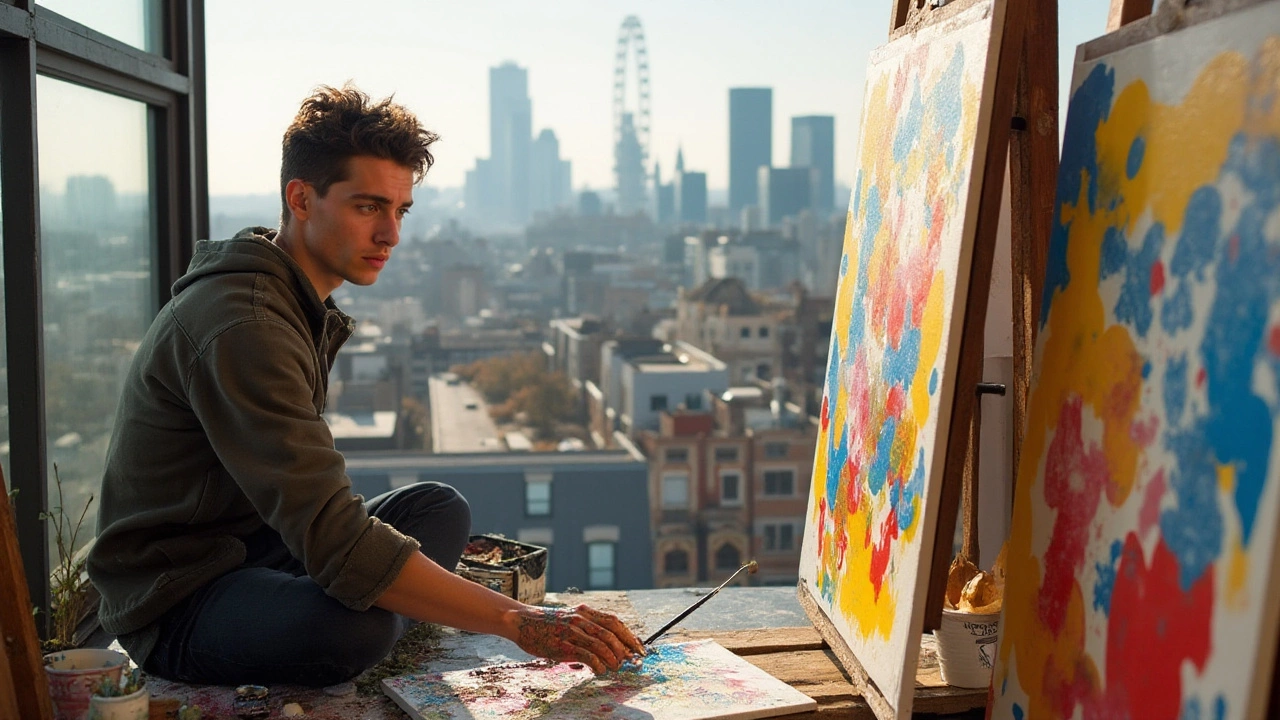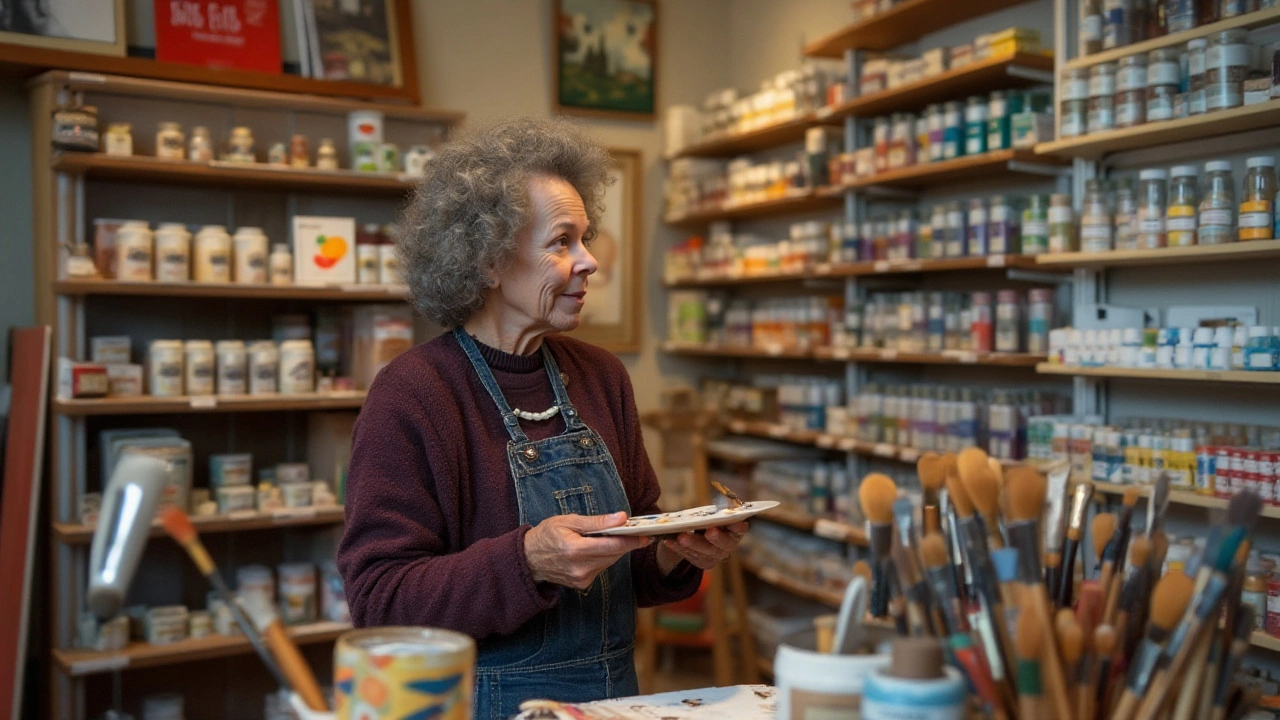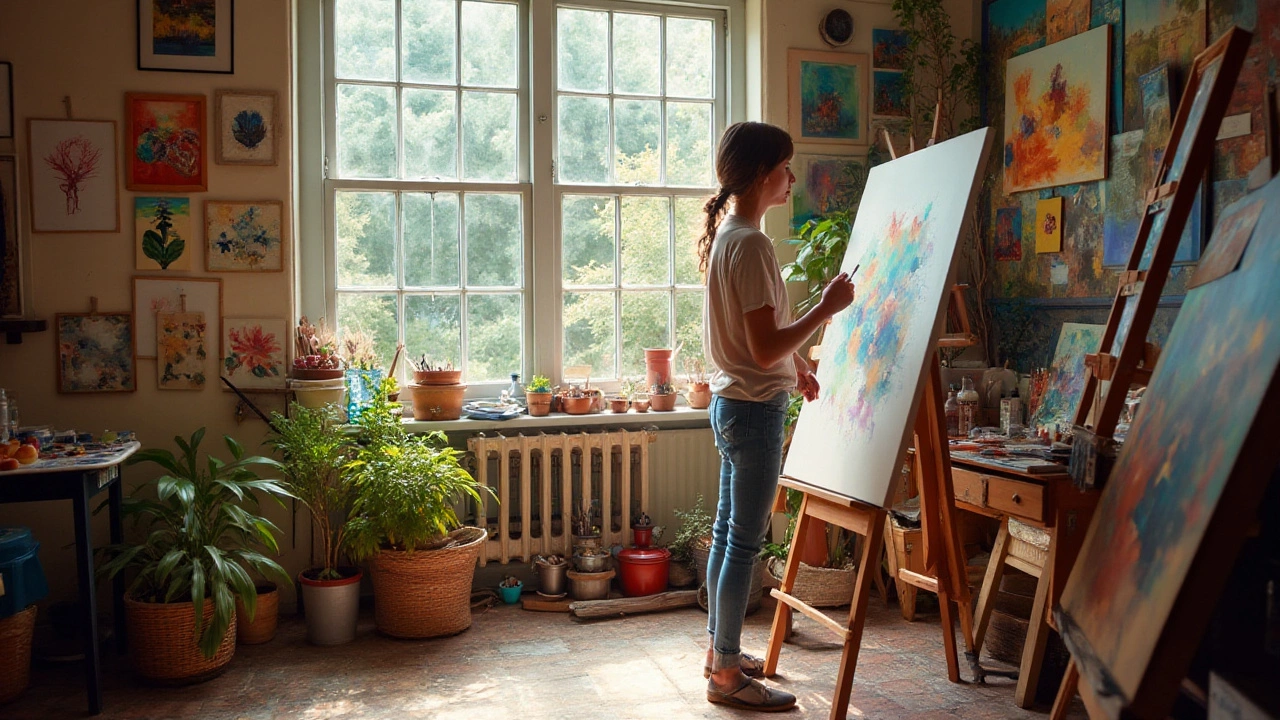Abstract painting invites artists to let go of the realistic constraints and embrace the limitless possibilities of imagination. Unlike traditional styles, abstract art emphasizes color, form, and texture rather than precise depictions of objects or landscapes.
For those just starting, it may feel like diving into the unknown. However, this journey begins with understanding the essence and principles that define abstract art, an area where rules bend and creativity reigns supreme.
This guide will walk you through picking the right tools, experimenting with techniques, and ultimately, discovering your own abstract style. As you embark on this artistic path, remember that abstract painting is as much about the process as the result.
- Understanding Abstract Art
- Choosing the Right Materials
- Exploring Different Techniques
- Finding Your Style
- Tips for Getting Inspired
Understanding Abstract Art
Abstract art defies the boundaries of conventional art by liberating it from realistic representations. It challenges both creator and observer to view the world through emotions, concepts, and sensations rather than literal forms. The roots of abstract painting can be traced back to the early 20th century, a radical departure from the traditions of art history. Movement pioneers, such as Wassily Kandinsky and Piet Mondrian, sought to express spiritual realities that transcended physical appearances. By discarding realistic representation, abstract art focuses on the essential aspects of visual experience — color, form, and line.
There are various interpretations and styles within abstract art, ranging from the chromatic explosions of Abstract Expressionism to the meticulous geometrical works of Minimalism. This spectrum allows artists to evoke mood and storytelling without explicit imagery. A significant aspect of abstract art is the engagement of the viewer's imagination. Unlike representational art, the interpretation of abstract work can be deeply personal and subjective, inviting a unique interaction every time. However, despite its perceived randomness, successful abstract work often involves a cohesive concept or underlying structure.
The psychological impact of color is a crucial component in abstract painting. Artists meticulously choose palettes to elicit specific emotions. For instance, the use of vibrant reds and oranges can incite a sense of urgency or vitality, while cooler blues and greens might calm or soothe. An influential advocate of abstract art, Jackson Pollock, once said, "The painting has a life of its own. I try to let it come through." This sentiment highlights the spontaneity often associated with the abstract creation, where the process becomes a dance between intentionality and accident.
It is useful for a beginner to not only appreciate the diverse styles but also understand the significance of personal expression in abstract art. Art critic Clement Greenberg famously commented that abstract art offers no comfort at the surface, requiring a deep dive into its substance. Emphasizing the process over the result can assist new painters in embracing mistakes as part of the creative journey. Beginners are encouraged to experiment with elements like texture, layering, and rhythm. Understanding the context and evolution of abstract art enriches personal practice and appreciation, offering insights into how artists over the decades have sought to convey emotion and concepts beyond the tangible.
As more artists embraced abstraction, the movement evolved to include numerous styles within its fold. While Kandinsky believed in the spiritual capability of colors and shapes, Mondrian’s work distilled the world to its simplest forms. These differing approaches underscore the importance of exploring various techniques and schools within abstract painting. For those new to abstract painting, studying these movements not only inspires but also provides a foundational understanding of how abstract art communicates on a different sensory level. By engaging with this rich history, aspiring artists can learn how previous abstractions have maintained relevance across time, influencing modern interpretations and practices.
Abstract art tips stress the notion that what often appears as chaos is underpinned by deliberate choices. This duality renders abstract painting as a dance between surrender to instinct and careful control. The balance is where creativity takes flight, making abstract painting an exciting, dynamic expression of the intangible.
Choosing the Right Materials
Venturing into the world of abstract painting requires selecting the right materials, an endeavor that can substantially enhance your creative journey. As you begin to experiment with abstract painting, understanding the role of each tool and material can make a significant difference in your artistic expression. Traditionally, artists may opt for canvas, a popular choice for its versatility and ability to hold various types of paint like acrylics or oils. Acrylic paints dry quickly, making them ideal for those who enjoy layering colors and experimenting with techniques, whereas oils allow more time to blend, providing a richer depth of color. This can foster your inner spontaneity as you navigate through different layers and textures.
Brushes play a crucial role, too, and choosing the right ones depends on the style you wish to pursue. Broad, flat brushes are excellent for larger strokes and background work, while finer, round brushes offer detailed attention to specific areas of the painting. Palette knives open another realm of possibility, allowing artists to sculpt and texture their work in ways that brushes do not always achieve. When selecting your tools, it might be helpful to visit local art supply stores and test various items firsthand to get a real feel for how they may contribute to your art.
A source of inspiration, Georgia O'Keeffe, once said,
"To create one's world in any of the arts takes courage."This sentiment is true as you begin experimenting with materials, encouraging you to try something new, perhaps unconventional in your exploration of abstract art. Don't shy away from trying different types of surfaces, too, such as wood panels or fine-art papers, which can yield different textures and effects that may inspire new avenues in your artwork.
For those keen on sustainability, it's worth noting the growing number of eco-friendly art supplies now available. Many manufacturers offer paints with non-toxic ingredients and brushes made from responsibly sourced materials. This aligns your artistic practices with environmental consciousness, contributing positively as you express yourself vividly on the canvas. Additionally, planning for proper storage of your materials is crucial to maintaining their longevity. Beginner artists often overlook this aspect; however, ensuring brushes are cleaned properly and paints are sealed tightly can avoid wastage and frustration down the line.
Setting up a space in your home dedicated to painting can also enhance your creative energy and process. Your workspace should be arranged to facilitate easy access to your paints, brushes, and canvases, allowing you to focus more on creating and less on searching for tools. Lighting is another essential aspect; natural light is beneficial, though proper artificial lighting solutions can augment this necessity, ensuring you see colors in their truest form.
In contemporary art, experimentation is key. As you become more familiar with your materials, you will find that understanding their limitations and strengths will push the boundaries of what you thought possible in creating your abstract art. Never hesitate to push those boundaries, for true art often lies just beyond the edge of comfort. Keep a journal of your experiments, noting how different materials react and combine; this practice not only aids in the learning process but serves as a source of inspiration for future projects. The selection of the right materials is a gateway to expressing the deepest parts of your creativity in a medium that is unbounded by the demands of realism.

Exploring Different Techniques
When it comes to abstract painting, experimenting with various techniques can significantly influence both your creative process and the final piece. One of the key approaches is the use of layering. By applying thin layers of paint, artists achieve depth and texture that enrich the canvas. This technique offers flexibility, allowing an abstract painter to either preserve transparency for ethereal visuals or build opacity for a bolder impact. Many artists find joy in watching how each layer interacts in unexpected ways, leaving traces of vivid history while forming abstract art.
Another popular technique is dripping and splattering paint across the canvas. This method is famously associated with artists like Jackson Pollock, who created rhythmic, spontaneous compositions that celebrate movement and energy. It encourages artists to embrace unpredictability. By letting paint fall naturally, an element of chance becomes part of your artwork. To master this, all you need is a loaded brush or tool to release pigment, allowing gravity to paint its path.
Texture plays a vital role in abstract art, influencing how viewers perceive a piece. Artists may embrace impasto by applying thick, rough strokes of paint that stand proud of the surface, adding tactile quality. Further exploration includes mixing materials, such as incorporating sand or fabric, to alter the painting's texture. These additions not only invite viewers to engage with the work more closely but also push the boundaries of traditional painting.
Using Unconventional Tools
Exploration thrives beyond the conventional; in abstract painting, artists are often drawn to non-traditional tools. Kitchen spatulas, credit cards, or even fingers can replace brushes to create dynamic and varied marks. These tools enable artists to discover unexpected textures and lines, breaking free from any imposed constraints and adding a personal flair to each abstract form.
As renowned artist Helen Frankenthaler once stated, "There are no rules. That is how art is born, how breakthroughs happen. Go against the rules or ignore the rules. That is what invention is about."
Experimenting with Color
Color theory holds significance in all art genres, but its influence in abstract art is unmatched. When exploring abstract painting, trying out bold, contrasting colors or subtle gradients can evoke different emotions and reactions. A deep understanding of color interaction helps to convey the intended mood. The harmonious blend or the collision of colors can guide a viewer's journey through the work. Many artists experiment by limiting their palette to challenge themselves in creating varied tones and shades from simple colors, fostering a more intimate relationship with their tools and chosen medium.
For those unafraid to push boundaries, marbling techniques offer a distinctive approach to color on canvas. Swirling paints together on a flat surface and then transferring onto a canvas can create fluid-like forms that dance with color and motion. These techniques celebrate the spontaneous and the unexpected, often leaving results that surprise even the creator.
Finding Your Style
Discovering your unique style in abstract painting may feel like an overwhelming task, especially for beginners. However, remember that style is often born from experimentation and the courage to try new things. It’s crucial to spend time exploring various techniques and tools to determine what truly resonates with you. Many artists find that their style evolves as they grow, much like personal taste or a signature. By experimenting with colors and textures, you're crafting a visual language that speaks uniquely to you. Consider starting with spontaneous brush strokes or playing with shapes that intrigue you. Allow your heart to guide your hand on the canvas; this intuitive approach often leads to delightful surprises.
When beginning to find your style, it can be helpful to immerse yourself in the works of renowned abstract artists. Study their techniques, explore what they convey without words, and let their legacy inspire you. Artists like Jackson Pollock and Wassily Kandinsky can be significant sources of inspiration. As Kandinsky aptly said,
"There is no must in art because art is free."His words remind us that finding a style isn’t about adhering to defined rules but breaking free from them. So take this as an invitation to interpret the world in your way, with your brushes singing tunes of color and form.
Emulating but not imitating these masters can be a powerful learning exercise and provides insight into how they developed their signature styles. Often, style emerges organically when you play with materials and let them guide your hands. Spend time painting without a predetermined outcome and see where your creativity takes you. Consider trying different techniques like layering paint with palette knives to create texture or employing unusual tools like squeegees or rollers. Exploring less conventional methods may lead you to discover a unique technique that evolves into your characteristic style.
Keeping a journal of your artistic journey, where you document thoughts and explore inspirations, can also be immensely beneficial. Record how you feel during the creative process and identify any patterns or favorite colors that frequently appear. Over time, you might notice your preferences and techniques starting to take shape. Connect with fellow artists by joining workshops or online communities dedicated to abstract art. Discussing your work with others and receiving feedback can help refine your style, challenging you to see your work from new perspectives. This artistic dialogue can ignite fresh inspiration, and these interactions are often where breakthroughs in style occur.
Fixing specific goals can direct your progress as you find your abstract voice. Consider what moods or messages you want to convey or what audience reactions you seek. Are you aiming for serene and minimalistic works, or do you want to channel chaotic energy with vibrant hues? Each painting is an opportunity to explore these questions and hone your direction. Remember that abstract art allows for constant evolution. Embrace the fluidity of your style, knowing it may shift and change with every new canvas. Celebrate the discovery of your voice without feeling pressured to remain static. Your style is alive, always developing as you do, growing with every layer of paint applied.

Tips for Getting Inspired
In the realm of abstract painting, inspiration often plays a critical role in fueling creativity and helping artists develop their unique voices. Many budding artists find themselves stalled simply because they haven’t found what moves them to paint. Start by immersing yourself in different art forms and everyday experiences, as inspiration can be found in the most unexpected places. Visiting art galleries can present a plethora of contemporary and historical pieces that might spark new ideas about color schemes or techniques. Even a stroll through a bustling market can offer a richness of sights, sounds, and experiences that translate into a dynamic painting.
Another valuable source of inspiration is nature. The natural environment is an ever-changing canvas full of varying textures, patterns, and colors. Take the time to sit in a park and observe the way light filters through leaves or notice the patterns created by a gentle breeze on a pond’s surface. Such observations can bring fresh perspectives to your paintings. Additionally, many artists find inspiration in diverse media such as music or literature. A moving piece of music might evoke emotions or imagery that compel you to express those sensations through your art.
Many accomplished artists keep an inspiration journal where they jot down thoughts, sketch ideas, or create small abstract thumbnails. This practice can be instrumental for generating new concepts and maintaining a flow of creativity. Exploring different techniques and mediums without the pressure of expectations is another viable strategy. Experiment with applying paint using non-traditional tools—a sponge, a palette knife, or even your fingers—to discover new textures and styles that may inform your work.
Artist Wassily Kandinsky once said, "There is no must in art because art is free." This wisdom highlights the idea that inspiration isn't about rules; it's about finding freedom in what moves you personally.
Moreover, consider creating or joining an art community, either online or locally. Engaging with like-minded individuals can provide support, motivation, and inspiration. Sharing your work and receiving feedback can open new avenues for creative growth. The beautiful thing about abstract painting lies in the absence of boundaries—feel free to mix techniques and play with color in unexpected ways. Finally, be patient with yourself. Remember, the inspirational muse may not always be present, and that's okay. Creativity comes in waves, and your next big idea might emerge when you least expect it.

